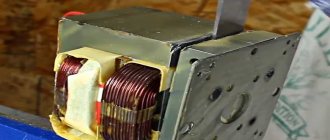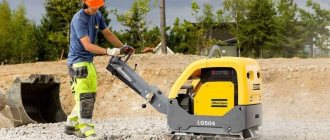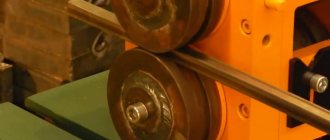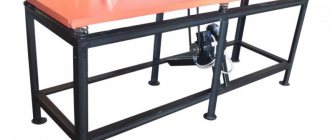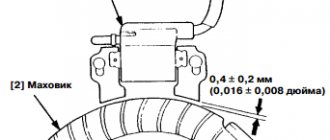Fan device and design
Sometimes an impeller and a power unit are not enough to move air. In conditions of limited space, a special type of exhaust equipment design should be used. It has a spiral-shaped body that acts as an air channel. You can make it yourself or purchase a ready-made model.
To form the flow, the design includes a radial impeller. It connects to the power unit. The wheel blades have a curved shape and create a discharged area when moving. Air (or gas) enters it from the inlet pipe. When moving along the spiral body, the speed at the outlet increases.
Depending on the application, the centrifugal fan volute can be general purpose, heat-resistant or corrosion-resistant. It is also necessary to take into account the amount of air flow created:
- low pressure. Area of application: production workshops, household appliances. The air temperature should not exceed +80°C. Mandatory absence of aggressive environments;
- average pressure value. It is part of exhaust equipment for removing or transporting small fraction materials, sawdust, grain;
- high pressure. Forms an air flow into the fuel combustion zone. Installed in many types of boilers.
The direction of movement of the blades is determined by the design, and, in particular, by the location of the outlet pipe. If it is located on the left side, the rotor should rotate clockwise. The number of blades and their curvature are also taken into account.
For powerful models, you need to make a reliable base with your own hands to secure the body. The industrial installation will vibrate strongly, which may lead to its gradual destruction.
Types of snails
Hoods - snails can vary in operating pressure. Each type has its own recommendations for use, namely:
Low pressure fans - up to 100 kg/m2. These designs can be used in both domestic and industrial premises. They are compact and do not require additional labor during installation. Medium pressure fans – up to 300 kg/m2. Industrial use is relevant for such systems. They cope well with various impurities. High pressure fans – up to 1200 kg/m2. Such fans are installed in hazardous industries, laboratories and paint shops.
Self-production
First of all, you should decide on the functional purpose of the centrifugal fan. If it is necessary for ventilation of a certain part of the room or equipment, the housing can be made from scrap materials. To complete the boiler, you will need to use heat-resistant steel or make it from stainless steel sheets yourself.
First, the power is calculated and the set of components is determined. The best option would be to dismantle the snail from old equipment - a hood or vacuum cleaner. The advantage of this manufacturing method is the exact match between the power of the power unit and the body parameters. A snail fan can be easily made with your own hands only for some applied purposes in a small home workshop. In other cases, it is recommended to purchase a ready-made industrial-type model or take an old one from a car.
Procedure to make a centrifugal fan with your own hands.
- Calculation of overall dimensions. If the device will be installed in a confined space, special damper pads are provided to compensate for vibration.
- Manufacturing of the body. If there is no ready-made structure, you can use plastic sheets, steel or plywood. In the latter case, special attention is paid to sealing the joints.
- Installation diagram of the power unit. It rotates the blades, so you need to choose the type of drive. For small structures, a shaft is used to connect the motor gearbox to the rotor. In powerful installations, a belt type drive is used.
- Fastening elements. If the fan is installed on the outer casing of, for example, a boiler, mounting U-shaped plates are made. With significant power, it will be necessary to make a reliable and massive base.
This is a general scheme according to which you can make an exhaust functional centrifugal unit with your own hands. It may change depending on the availability of components. It is important to comply with the requirements for sealing the housing, as well as to ensure reliable protection of the power unit from possible clogging with dust and debris.
The fan will make a lot of noise during operation. Reducing this will be problematic, since vibration of the housing during the movement of air flows is almost impossible to compensate with your own hands. This is especially true for models made of metal and plastic. Wood can partially reduce background noise, but at the same time it has a short service life.
In the video you can see the process of manufacturing a case from PVC sheets:
Homemade snail
Before starting to create a homemade system, craftsmen recommend deciding on the functional purpose of the future device. A centrifugal fan, that is, an umbrella made from simple available materials, is suitable for partial cleaning of premises or complex equipment.
In cases where a do-it-yourself snail fan is intended for boilers, the body of the device must be made of heat-resistant steel sheets. A home-made centrifugal fan is made from old parts of a vacuum cleaner or cleaning system of a residential building. Fans such as a snail or an umbrella will serve well in small workshops, but for large-scale enterprises such devices will be of little use.
The entire process of creation and subsequent connection of the fan takes no more than two days, taking into account fast and high-quality work at all stages. First, calculate all the parameters of the future device, including the outer box and insulation. It would be a good idea to consider the option of additional gaskets that reduce the vibration effect from the operation of the snail device.
Homemade “Snail” fan is made from improvised materials
The centrifugal fan is mounted in the outer casing and mounted on a fixed base.
You can use a simple circuit to make and then connect a homemade device called an umbrella, supplement it and equip it with all the necessary elements for working in a given room. The main thing is to comply with all fire safety standards and use the snail for its intended purpose.
DIY centrifugal fan
A low-power centrifugal fan will be of little use. Even quiet hoods are equipped with commutator motors that make a lot of noise. If the fact doesn’t frighten you, let’s proceed to choosing funds. We'll show you how to make a centrifugal fan with your own hands from scrap items. If in a typical axial fan the motor and impeller are important, here, in addition to everything else, the housing is added. Let's try to assemble a centrifugal fan ourselves.
Operating restrictions
Despite the strength and reliability of industrial snails, there are some restrictions on their use. So, centrifugal fans, commonly called “snails”, are not recommended to be installed if:
- There are suspensions in the air with a sticky consistency of more than 10 mg/cubic meter.
- There are particles of explosive substances in the room.
- The room temperature is outside the range of -40 to +45°C.
Moreover, it is rational to use snail ventilation in large rooms; in everyday life, it is better to install such devices in ventilation shafts, where all the exhaust air from the house enters.
What is a centrifugal fan
A centrifugal fan is used as a duct fan. To make things easier, the vacuum cleaner contains what looks like a duct fan. Now think:
- The dust is sucked up by a hose.
- Passes into the bag (tank, compartment).
- Passes filtration.
- The engine passes.
- It is ejected from the back of the case.
What it does is that there is a centrifugal fan inside, formed by a drum (squirrel cage) mounted on the motor shaft. This is not enough. The engine with the impeller is enclosed in a sealed housing, through the channels of which the air escapes to the outside. Without a tight casing, the meaning of the centrifugal fan will be lost. Here's the main difference. Unlike axial fans, which often serve for personal needs, centrifugal fans are used in the economic sphere: room ventilation, cleaning, air purification. To understand how to make a centrifugal fan, let's study the principle of operation of the device.
Centrifugal fan: operating principle of the design
The popularity of this equipment largely depends on efficiency and economic feasibility. The centrifugal fan is designed in such a way as to maximize these indicators.
The air, falling on the blades, is deflected at an angle of 90 0. Then it passes through the spiral casing of the centrifugal fan and only then enters the room. Thus, the most efficient circulation of air flows in the room is achieved.
You can buy a fan in our online store. Our catalog contains a large selection of different models: axial centrifugal air fan, centrifugal exhaust air fan, etc. Here you can easily choose a suitable centrifugal fan, the characteristics, price and quality of which will meet your requirements. We give our clients the opportunity to buy a centrifugal fan at a profit - the cost of the equipment will pleasantly surprise you.
Operating principle of a centrifugal fan
A centrifugal fan operates due to the dynamic characteristics of the flow. Try tying a stone to a thread and twisting it around yourself in a horizontal plane. The hand feels a noticeable tension; if the connection were broken, the projectile would immediately fly out tangentially to the circular path of rotation. Air molecules behave similarly: the wheels on the blades acquire significant speed and, unrestrained by anything, are carried away to the outer perimeter. Then the channel system gives the flow the desired direction. Finally, air enters centrally, usually on the side opposite the engine.
Inside the vacuum cleaner we see a picture:
- Air from the bag (tank, container), cleaned of dust, approaches the engine from the front and enters the center of the drum.
- The molecules, accelerated by the blades to a significant speed, are thrown out. They pass through the channels of the sealed housing, simultaneously cooling the engine, and leave the belly of the vacuum cleaner from the back side.
Design feature: the blades of a centrifugal fan create pressure; if the housing is leaky, the air flow will be disrupted. Therefore, the difficulty for a self-taught master is to create the right conditions.
Good hoods use motors with tangential (centrifugal) type fans. In selected designs, the design surprises with a duet of squirrel cages. In the latter case, a pair of impellers is mounted on either side of the engine on a shaft. Then the air enters from two directions perpendicular to the plane of rotation of the wheels. Thus, the efficiency of the centrifugal fan increases.
How to make a centrifugal fan
From what has been said, the obvious way to achieve this is to remove the tangential fan from the hood, for example. Advantage: Silent operation is ensured. The manufacturer complies with the norms prescribed by the standards, so factory-made devices of the hood class are relatively quiet. We believe that for most readers this is not the best solution to the problem, let’s continue our consideration.
Vacuum cleaner
Inside the vacuum cleaner there is a ready-made centrifugal fan. A big plus is that there is already a ready-made housing that needs to be mounted in the channel on site. Additional benefits include:
- The vacuum cleaner engine is designed for long-term operation. Spins the blade for days on end. The windings are often protected from overheating; in addition, air passes through the channels, cooling the stator.
- The vacuum cleaner engine is designed to overcome significant pneumatic loads. When you disassemble this housewife's assistant yourself, you will see a safety valve inside. Try removing it and blowing it out with your lungs. Does not work? And the engine does this in jest! Pinch the inlet or bend the hose in half. A click coming from the inside of the case indicates activation. We believe that such a force will be more than enough to ventilate the facility.
- Plus - the suction power (in aerowatts) is indicated in the technical specifications, similar to the pressure created. Thus, it is easy to calculate in advance using formulas whether the engine power is sufficient for the selected task. Sometimes manufacturers are so kind that they indicate the flow rate, for example, 3 cubic meters per minute. Anyone can do the math: 180 cubic meters per hour. Thanks to the high power, the flow rate will be maintained despite the turns and bends of the air duct.
Popular models
In principle, there is no model division of snails. There are certain brands that are produced by all manufacturers. And they are divided mainly according to their intended purpose. For example, a VRP fan, where the letter “P” means that this is a dust model, which is used in ventilation and aspiration systems to remove air with a high concentration of dust. That is, this is a specific model that must be used for its intended purpose. Of course, this device can easily handle ordinary air, but it is more expensive than standard VR or VC, because its design uses thick metal to make the body and blades, hence the higher power of the electric motor.
The same applies to VR DU brand fans, that is, for smoke removal. They are made from higher quality materials with the installation of an explosion-proof motor. Hence their high price. As for other positions, VR is divided into types that have already been mentioned, and each group has its own models with its own technical characteristics.
Adjusting the centrifugal fan motor
In 85% of cases, the motor in a washing machine is a commutator motor. These, by the way, also operate on direct current. The direction of rotation is determined by the polarity of the voltage.
About the speed control scheme. The operating principle of a centrifugal fan requires the use of spin modes. Find the thyristor circuit that regulates the cutoff angle and adjust it as needed. For maximum speed, connect the engine to a 220 V network. We consider the questions of what a centrifugal fan is and how to make one to be answered.
Centrifugal fan: equipment design
Ventilation systems equipped with this equipment have high potential even in difficult climatic conditions. A centrifugal fan is a structure consisting of several components:
- spiral body;
- impeller;
- impeller blades;
- electric motor.
All parts of the structure are connected by spot welding, rivets and bolts, which ensures reliability. The centrifugal fan often has a powder-coated stainless steel housing, which minimizes the possibility of corrosion. Indicators such as efficiency and vibration level depend on the direction of blade bending.
Device and design
Radial fans move air flows using an impeller installed inside a housing of a specific shape. The name “snail” arose due to some similarity in the appearance of the body with a spiral-shaped shell. The impeller has the form of a drum equipped with blades located parallel to the axis of rotation. The operation of the device occurs in close interaction between the housing and the impeller, the functions of which are equally important.
Suction occurs in the direction of the axis of rotation, and discharge occurs tangentially to it, perpendicular to the suction . As the blades rotate, they capture air particles and forcefully throw them out in a centrifugal direction. The fan housing does not allow the flow to dissipate, directing it to the outlet. A vacuum is formed in the area of the central part of the impeller, which is immediately replenished by inflow from the inlet located in the central part of the flat side of the housing.
Design Features
Scroll hoods differ in structure from standard fans with large blades. Air flows in such equipment move due to centrifugal force resulting from the rotation of a wheel with small specially shaped blades. The speed and power of such hoods may vary depending on the number of blades and motor parameters
.
The air purification scheme in radial centrifugal hoods is quite simple: when air gets inside the hood, it begins to be sucked into the rotor, where it begins to rotate and is subject to pressure, gradually moving towards the outlet and being cleared of foreign elements. The general shape of the inlet and outlet channels resembles a snail - hence the name of this hood.
Attention!
Designs of this type are useful in that they can both suck in air and ensure its outflow.
The housing of this type of ventilation system is made of durable materials such as aluminum, brass or steel. Plastic structures are also available for sale, but they are less durable and rarely work at maximum efficiency.
Since air treatment can be carried out at high temperatures, the housing is treated with protective paint, chemical-resistant substances, and is also coated with polymers.
The rotation mechanisms in such a system can be single, or they can include two disks with blades of the required size. Both radial and circular placement of the blades ensure high performance of the device.
Advice:
For better air purification, purchase fans with blades that are slightly curved rather than flat.
Despite the uniform shape, such hoods are suitable for many operating conditions, since they differ in orientation to the right or left side, and in overall dimensions. On average, the diameter of the main body of such a hood can range from 25 to 150 cm
.
For ease of installation for industrial purposes, many structures of this type are created modular, and fastening bolts are used to connect them. Accordingly, you will be able to change both the angle of inclination and the details of some parts of such a design for greater efficiency: it is better to first calculate all the parameters with specialists
.
Since snails can differ from each other, you should not focus solely on size and power ratings. Familiarize yourself with their varieties - and make a choice, relying on future operating conditions.
Self-production
Let's consider how you can create a snail fan with your own hands, the drawings of which can be found on the Internet or made yourself.
Drawing
Video review
Working wheel
First of all, you need to get an impeller. This is important because it is a fairly massive element and requires good balancing . If the impeller beats even a little, the bearings of the electric motor (or its own drive shaft) will quickly fail. Ready-made impellers from fans or air conditioners are often used, but if you can’t find them, you’ll have to make them yourself.
Landing sleeve
First of all, you need to make a landing coupling. It is made on a lathe . The coupling is then attached to the sheet metal by welding or screws, clamped in a lathe and carefully centered. The result is a round disk with a seating sleeve in the center. Markings are made on it and the blades are attached. Making a drum-type impeller with your own hands is impractical, since high-quality balancing of homemade elements is impossible.
Frame
For the body, sheet steel or, as in the example in the video, wood is used. A strip 0.5-1 cm wider than the thickness of the impeller is cut out of it. The strip is bent, giving it the shape of a snail. This is the side of the body. Then two identical parts are made, repeating the profile of the side element.
One of the parts will become the outer side of the housing; a suction hole is made and a flange is secured for mounting air ducts or grilles. The second part is attached to the motor housing and has a hole for the passage of its shaft. It is secured to the engine with bolts , the side curved part is welded to it with a continuous seam without gaps. Bolts are welded to the edge, which will press the outer part with the suction hole.
Snail design
A standard volute (umbrella) consists of an impeller and a power unit. Your fan, depending on its assigned functions, may have protective properties against corrosion or be characterized by increased heat resistance.
The structure of the snail is selected directly for the room in which an additional cleaning system should be installed. When choosing a device, it is recommended to take into account the strength of the air flow, namely:
- low pressure flows;
- average pressure;
- high pressure flows.
When choosing a “Snail” fan, you should take into account the strength of the air flow
Professionals warn that the more powerful the ventilation unit, the more effort should be put into installing it. A homemade box or base will facilitate quick connection and correct operation of the entire device for a long time.
What is a centrifugal fan
A centrifugal fan is used as a duct fan. To make things easier, the vacuum cleaner contains what looks like a duct fan. Now think:
- The dust is sucked up by a hose.
- Passes into the bag (tank, compartment).
- Passes filtration.
- The engine passes.
- It is ejected from the back of the case.
What it does is that there is a centrifugal fan inside, formed by a drum (squirrel cage) mounted on the motor shaft. This is not enough. The engine with the impeller is enclosed in a sealed housing, through the channels of which the air escapes to the outside. Without a tight casing, the meaning of the centrifugal fan will be lost. Here's the main difference. Unlike axial fans, which often serve for personal needs, centrifugal fans are used in the economic sphere: room ventilation, cleaning, air purification. To understand how to make a centrifugal fan, let's study the principle of operation of the device.
Operating principle of a centrifugal fan
A centrifugal fan operates due to the dynamic characteristics of the flow. Try tying a stone to a thread and twisting it around yourself in a horizontal plane. The hand feels a noticeable tension; if the connection were broken, the projectile would immediately fly out tangentially to the circular path of rotation. Air molecules behave similarly: the wheels on the blades acquire significant speed and, unrestrained by anything, are carried away to the outer perimeter. Then the channel system gives the flow the desired direction. Finally, air enters centrally, usually on the side opposite the engine.
Inside the vacuum cleaner we see a picture:
- Air from the bag (tank, container), cleaned of dust, approaches the engine from the front and enters the center of the drum.
- The molecules, accelerated by the blades to a significant speed, are thrown out. They pass through the channels of the sealed housing, simultaneously cooling the engine, and leave the belly of the vacuum cleaner from the back side.
Design feature: the blades of a centrifugal fan create pressure; if the housing is leaky, the air flow will be disrupted. Therefore, the difficulty for a self-taught master is to create the right conditions.
Good hoods use motors with tangential (centrifugal) type fans. In selected designs, the design surprises with a duet of squirrel cages. In the latter case, a pair of impellers is mounted on either side of the engine on a shaft. Then the air enters from two directions perpendicular to the plane of rotation of the wheels. Thus, the efficiency of the centrifugal fan increases.
How to make a centrifugal fan
From what has been said, the obvious way to achieve this is to remove the tangential fan from the hood, for example. Advantage: Silent operation is ensured. The manufacturer complies with the norms prescribed by the standards, so factory-made devices of the hood class are relatively quiet. We believe that for most readers this is not the best solution to the problem, let’s continue our consideration.
Vacuum cleaner
Inside the vacuum cleaner there is a ready-made centrifugal fan. A big plus is that there is already a ready-made housing that needs to be mounted in the channel on site. Additional benefits include:
- The vacuum cleaner engine is designed for long-term operation. Spins the blade for days on end. The windings are often protected from overheating; in addition, air passes through the channels, cooling the stator.
- The vacuum cleaner engine is designed to overcome significant pneumatic loads. When you disassemble this housewife's assistant yourself, you will see a safety valve inside. Try removing it and blowing it out with your lungs. Does not work? And the engine does this in jest! Pinch the inlet or bend the hose in half. A click coming from the inside of the case indicates activation. We believe that such a force will be more than enough to ventilate the facility.
- Plus - the suction power (in aerowatts) is indicated in the technical specifications, similar to the pressure created. Thus, it is easy to calculate in advance using formulas whether the engine power is sufficient for the selected task. Sometimes manufacturers are so kind that they indicate the flow rate, for example, 3 cubic meters per minute. Anyone can do the math: 180 cubic meters per hour. Thanks to the high power, the flow rate will be maintained despite the turns and bends of the air duct.
The disadvantage of the vacuum cleaner engine is noise. In addition, the commutator motor sparks, which creates interference along the power supply. You will need to make a surge protector so as not to burn out your imported home equipment. The noise level is high. Exceeds 63 dB allowed to be produced in an apartment by law.
Washing machine
What else can you use to assemble a centrifugal fan? The image of a front-loading washing machine came to mind. If you remove the door and make channels in the housing so that the flow cools the motor windings, you will get a centrifugal fan. Plus - the working compartment of the washing machine is sealed. Simply remove the tank wall near the engine to create something like a centrifugal fan. The drum will have to be radically redesigned to capture air. The housing will need to be disassembled.
The main dilemma arises: is it worth dismantling the tank? Most models are specially designed so that the operation cannot be performed without damaging the fasteners. This helps service centers track the sly ones doing the repairs. In any case, the drum is cut in place to make blades in the walls. Bend the steel inward so that the structure does not touch the tank. Option: from the walls of a steel cylinder, and bend the blades of the desired shape in the image and likeness of factory industrial models of centrifugal fans.
The main thing seems to be the correct selection of speed. 1000 spin rotations is quite enough. The drum diameter is large. The vacuum cleaner produces 6000-16000 rpm, but the radius of the blades is much smaller. Therefore, it is necessary to estimate the linear speed. As you know, the circumference is directly proportional to the radius, therefore, if the diameter of the drum of a Samsung washing machine is 45 cm, it is at least three times larger than that of a vacuum cleaner - equivalent to a speed of 3000 revolutions per minute (minimum). But! In this case, the wheel area is much larger, therefore, the flow is enormous.
From the above, we conclude that a speed of 1000 rpm, especially 1500 rpm, is enough to independently make a centrifugal fan from a washing machine. The performance is approximately the same, but the specific flow pressure will be reduced. Much depends on the shape of the blades; we strongly recommend that you inquire on the forum of physicists and hydraulics. The simplest option is to borrow a blade from a floor fan. The plastic is welded using a set of plastic bags and a soldering iron, which will strengthen the flywheel on the shaft.
The main thing is to maintain tightness. It is recommended to seal the extra holes that abound in the drum. A homemade centrifugal fan from a washing machine is dangerous to operate (if there are safe tangential fans), it is recommended to close the hatch for loading laundry with a strong grille. For example, make a number of holes on the front side of the case for installing the element. The centrifugal fan device is complemented by a durable fence. Make the grate from a steel rod and fasten it with bolts.
General information about centrifugal (radial) fans
Coil fans have a dual designation (marking): VR and VC, that is, radial and centrifugal. The first indicates that the blades of the working part of the equipment are located radially relative to their rotor. The second is the designation of the physical principle of operation of the device, that is, the process of intake and movement of air masses occurs due to centrifugal force.
It is centrifugal fans in ventilation systems that have shown themselves on the positive side due to the high efficiency of air removal.
Operating principle
As already mentioned, fans of this modification operate based on the action of centrifugal force.
- The blades attached to the rotor of the device rotate at high speed, creating turbulence inside the housing.
- The inlet pressure drops, which causes the suction of nearby air, which rushes inward.
- Under the action of the blades, it is thrown to the periphery of the space, where high pressure is created.
- Under its action, the air flow rushes to the outlet pipe.
This is how all centrifugal models work, which are installed not only in ventilation systems, but also in smoke removal systems. About the latter, it must be said that their body is made of aluminum alloy or steel, coated with heat-resistant materials, and is equipped with an explosion-proof electric motor.
Design Features
As already mentioned, the main design feature is the snail. It is also necessary to indicate the shape of the blades. Fans of this brand use three types:
- with straight slope,
- with a backward tilt
- in the form of a wing.
The first position is small fans with high power and performance. That is, they can create conditions in which other models require a large body. At the same time, they operate with low noise levels. The second position is an economical option that consumes 20% less electricity than other positions. Such fans can easily withstand loads.
As for the design that relates to the electric motor, there are also three positions:
- the rotor is fixed directly to the motor shaft through a coupling and bearings;
- through a belt drive using pulleys;
- The impeller is mounted on the electric motor shaft.
And one more feature is the connection points between the fan and the air ducts of the ventilation system. The inlet pipe has a rectangular hole shape, the outlet is round.
Adjusting the centrifugal fan motor
In 85% of cases, the motor in a washing machine is a commutator motor. These, by the way, also operate on direct current. The direction of rotation is determined by the polarity of the voltage.
About the speed control scheme. The operating principle of a centrifugal fan requires the use of spin modes. Find the thyristor circuit that regulates the cutoff angle and adjust it as needed. For maximum speed, connect the engine to a 220 V network. We consider the questions of what a centrifugal fan is and how to make one to be answered.

